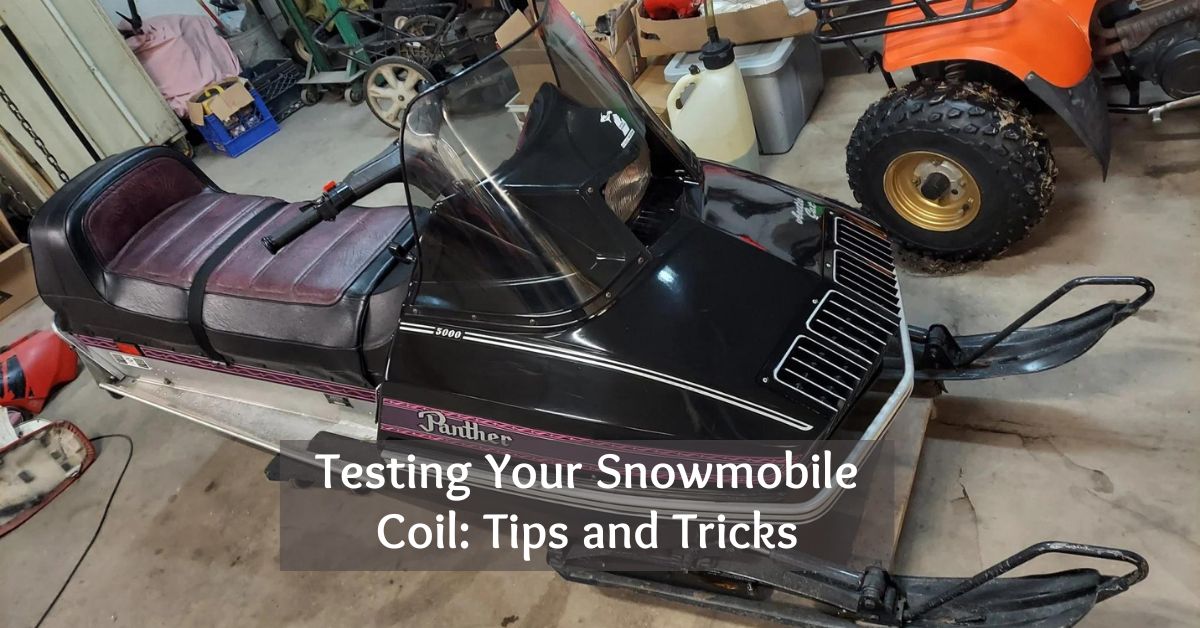Snowmobiles run on some of the toughest terrains and take the brut force of nature. So it is important to maintain this machinery properly to get the best out of it. Here we will talk about how to test a snowmobile coil, a small device required for engine function using a Multimeter and Ohmmeter. Let’s begin with some basics first.
What Is An Engine Coil?

A coil in an engine is a spiral of wire that assists in the creation of a magnetic field. This magnetic field subsequently generates the spark that ignites the engine’s fuel.
The coil is divided into two sections: the primary winding and the secondary winding. The main winding has fewer turns of heavier wire than the secondary winding, which has more turns of thinner wire.
Electricity goes from the battery through the primary winding when the engine is running. A magnetic field is formed around the secondary winding as a result of this.
When the spark plug has to be ignited, a voltage is applied to the secondary winding, which amplifies it and transfers it to the spark plug.
Do You Know Different Types Of Engine Coils?
There are three main types of ignition coils.
Standard Coil
The most common form of ignition coil is the ordinary coil. It is made up of two wire windings wrapped around a metal core. The primary winding gets current from the battery and generates a magnetic field when the engine is running.
This magnetic field causes a current in the secondary winding, resulting in the spark that ignites the air-fuel combination in the cylinders.
Electronic Ignition Coil
The electronic ignition coil replaces the traditional coil. It controls the flow of current via the primary winding with transistors. This enables for more exact spark timing, which can lead to improved engine performance.
Distributorless Ignition Coil
The most advanced type of ignition coil is the distributor ignition coil. The flow of current through the primary and secondary windings is controlled by a computer. This enables for more exact spark timing, which can lead to improved engine performance.
Why Should You Check Coil?
Testing the ignition coil in your snowmobile will help you to troubleshoot common engine problems like misfiring, backfiring, problems with fuel efficiency, and hard startups.
Being able to self-check the problem will help in reducing the overall maintenance cost and unnecessary visits to the mechanic shop. It might also help you to revive your snowmobile if you are stuck in an isolated area.
Suggested Reads: Is Snowmobile Insurance Worth It?
Signs of Faulty Ignition Coil You Should Know
Engine Misfire
An engine misfire causes the automobile to tremble and seem out of sync. When the car is stationary, it also causes vibrations and rough idling. This occurs when the fuel fails to ignite consistently during the combustion cycle.
It is possible that the spark plugs are deteriorating, but it is also possible that the charge from the battery is insufficient and that the ignition coil has to be replaced.
If the combustion cycle does not function smoothly, the engine will not be as powerful, and you will notice a difference in performance.
If you notice that you’re stalling more often or that the engine is slow when you press the gas pedal, you should get the ignition coil checked.
Engine Backfires
A backfire occurs when unburned fuel ignites in the exhaust system and sounds like a bang or harsh cough. Backfiring can cause harm to other elements of your snowmobile if left unchecked, therefore it should always be checked.
However, it is occasionally produced by the ignition coil failing to ignite the fuel during the combustion cycle, enabling it to enter the exhaust system.
Reduced Fuel Efficiency
If the spark plugs do not receive enough charge to ignite and fuel escapes unburned into the exhaust system, it is wasted. This could imply that your snowmobile is getting fewer miles per gallon and that you’re paying more at the pump.
If you discover that you need to fill up your car more frequently, make an appointment to have the ignition coil checked.
Check Engine Light
On modern vehicles, a malfunctioning ignition coil is sufficient to make the Check Engine signal light up on your dashboard. This is always a reason to book a diagnostic at your dealership straight away.
Hard Starts
Without an effective ignition coil, the engine might struggle to get going. This will mean that it coughs for longer and takes more time to turn over when you press the ignition switch, or that it takes a few attempts to get it going.
Hard starts are tough on other engine parts, so this is another good reason to get the ignition apparatus checked.
How To Test A Snowmobile Coil?
How To Test A Snowmobile Coil Using Multimeter?
Let’s discuss how to test ignition coil with multimeter.
STEP 1 Turn on the digital multimeter and set the measurement dial to resistance. Resistance is measured in ohms and represented by the capital Greek letter omega on the dial.
STEP 2 Connect the multimeter’s red (positive) probe to the positive, outside post of the ignition coil. To measure the resistance of the primary coil, place the multimeter’s black (negative) probe against the device’s outer, negative post. If the reading differs from the one in the handbook, the ignition coil needs to be replaced.
STEP 3 Connect the multimeter’s black probe to the ignition coil’s central, negative terminal. This generates a secondary coil resistance reading. Again, if the tested resistance differs from what is specified in the owner’s manual, the ignition coil has failed.
How To Do Ohms Test On Ignition Coil Using Ohmmeter?
A snowmobile coil is similar to a capacitor. It can accept 12 volts, raise the voltage significantly, and store it until it is grounded. The field collapses and releases this energy through its second terminal when it is grounded. The degree of voltage rise is totally determined by the number of field windings and the type of fluid around it.
STEP 1 Using a small electrical wrench, remove the two wires from the coil. The positive and negative terminals will be here.
STEP 2 Connect the ohmmeter’s red lead to the positive (+) wire and probe the coil mounting bracket with the black lead. The display should be endless (there should be no reading or continuity). If there is any continuity, the coil has been shorted and must be replaced.
STEP 3 Connect the black lead to the coil’s negative terminal (-) and observe the output. The value should be less than one ohm.
STEP 4 Bring the black lead up to the coil tower and probe the contact inside. The measurement should be between 10 and 60 ohms. Replace the coil if any of these tests failed.
This concludes our article on How To Test A Snowmobile Coil. We hope you find this article useful and if so please like and share this article. Also, comment down your suggestions below.
You may also like Snowmobile Maintenance Checklist| Complete 2023 Guide.
FAQs (Frequently Asked Questions)
How do you test a coil with a multimeter?
Set your multimeter to the lowest ohms setting, which is usually 20 or 200. To determine the overall resistance of the coil in the atomizer, place one probe on the positive pin (the one in the inside of the 510 connection) and the other on the outer 510 threading.
How many ohms Should a coil read?
The coil’s ohmic resistance is approximately 0.2-3.0 on the main side and approximately 5-20 k on the secondary side. The primary to secondary winding ratio is 1:100. The technical construction may differ depending on the application of the ignition coil.
How can you tell if an ignition coil is weak?
Signs of a Faulty Ignition Coil:
1. Loss of Power
2. Check the Engine Light On
3. Poor Fuel Economy
4. Backfiring
5. Misfiring Engine
6. Hard Starts and Stalling
7. Spluttering and Coughing Sounds
8. Jerking and Vibrating
How many volts should a coil read?
The voltage reaching the coil may be 12 volts, or approximately 7 volts if the coil is equipped with a ballast resistor. Most electrical equipment operates on 12 volts, although most current automobiles include a resistor in the ignition system to help in starting. A ballast-resistor system’s coil is rated at 7-8 volts rather than 12 volts.
What is the resistance of a coil?
An atomiser’s (coil’s) resistance relates to the regulation of electricity (wattage or voltage from your battery/mod) to the coil. Resistance is measured in “Ohms” () and on coils is usually between 0.15 and 2.1.







